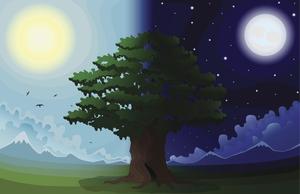Glossary term: Day
Description: In English as well as in numerous other languages, "day" has multiple meanings. "Day" in the sense of "daytime" describes the time when the Sun provides us with natural light, followed by the night when the Sun has set, and it is dark. A day by this definition is shorter in the winter and longer in the summer in the northern hemisphere, while the opposite holds for the southern hemisphere. In the far north or the far south, there is a time of year where the Sun does not set at all – directly at the poles, the Sun is up for six months without setting!
"Day" is also the name of the 24-hour unit of time we use in the calendar. Astronomically speaking, the time from one local noon to the next – that is, from the day's highest position of the Sun above the horizon from one day to the next – is called an apparent solar day. The length of local days varies depending on the time of year, owing to the facts that (a) Earth's orbit is elliptical (with Earth moving faster when it is closer to the Sun), and that (b) the apparent trajectory of the Sun in the sky is at different angles relative to Earth's equator. For practical purposes, timekeeping instead uses the average length of apparent solar days, which are called mean solar days. The associated time at 24 hours per day is called mean solar time.
A sidereal day is based on the "fixed" background stars on the celestial sphere. It is the period between the time a "fixed" star reaches its highest point in the sky to the next time it reaches its highest point in the sky. One sidereal day lasts approximately 23 hours 56 minutes and 4 seconds. The discrepancy between this and an apparent solar day (24 hours) is caused by the Sun's apparent motion relative to the "fixed" background stars.
Related Terms:
See this term in other languages
Term and definition status: This term and its definition have been approved by a research astronomer and a teacher
The OAE Multilingual Glossary is a project of the IAU Office of Astronomy for Education (OAE) in collaboration with the IAU Office of Astronomy Outreach (OAO). The terms and definitions were chosen, written and reviewed by a collective effort from the OAE, the OAE Centers and Nodes, the OAE National Astronomy Education Coordinators (NAECs) and other volunteers. You can find a full list of credits here. All glossary terms and their definitions are released under a Creative Commons CC BY-4.0 license and should be credited to "IAU OAE".
If you notice a factual error in this glossary definition then please get in touch.
Related Activities
Why Do We Have Day and Night?
astroEDU educational activity (links to astroEDU website) Description: Explore day and night of Earth.
License: CC-BY-4.0 Creative Commons Attribution 4.0 International (CC BY 4.0) icons
Tags:
Tilt
Age Ranges:
6-8
, 8-10
, 10-12
Education Level:
Primary
, Secondary
Areas of Learning:
Modelling
, Structured-inquiry learning
, Social Research
Costs:
Low Cost
Duration:
1 hour 30 mins
Group Size:
Group
Skills:
Asking questions
, Communicating information









